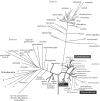Hyperthermophiles in the history of life
- PMID: 17008222
- PMCID: PMC1664684
- DOI: 10.1098/rstb.2006.1907
Hyperthermophiles in the history of life
Abstract
Today, hyperthermophilic ('superheat-loving') bacteria and archaea are found within high-temperature environments, representing the upper temperature border of life. They grow optimally above 80 degrees C and exhibit an upper temperature border of growth up to 113 degrees C. Members of the genera, Pyrodictium and Pyrolobus, survive at least 1h of autoclaving. In their basically anaerobic environments, hyperthermophiles (HT) gain energy by inorganic redox reactions employing compounds like molecular hydrogen, carbon dioxide, sulphur and ferric and ferrous iron. Based on their growth requirements, HT could have existed already on the early Earth about 3.9Gyr ago. In agreement, within the phylogenetic tree of life, they occupy all the short deep branches closest to the root. The earliest archaeal phylogenetic lineage is represented by the extremely tiny members of the novel kingdom of Nanoarchaeota, which thrive in submarine hot vents. HT are very tough survivors, even in deep-freezing at -140 degrees C. Therefore, during impact ejecta, they could have been successfully transferred to other planets and moons through the coldness of space.
Figures










Similar articles
-
History of discovery of the first hyperthermophiles.Extremophiles. 2006 Oct;10(5):357-62. doi: 10.1007/s00792-006-0012-7. Epub 2006 Aug 29. Extremophiles. 2006. PMID: 16941067 Review.
-
Extremophiles and their adaptation to hot environments.FEBS Lett. 1999 Jun 4;452(1-2):22-5. doi: 10.1016/s0014-5793(99)00663-8. FEBS Lett. 1999. PMID: 10376671 Review.
-
Hyperthermophiles in the history of life.Ciba Found Symp. 1996;202:1-10; discussion 11-8. Ciba Found Symp. 1996. PMID: 9243007 Review.
-
A brief history of the discovery of hyperthermophilic life.Biochem Soc Trans. 2013 Feb 1;41(1):416-20. doi: 10.1042/BST20120284. Biochem Soc Trans. 2013. PMID: 23356321 Review.
-
Hyperthermophilic life at deep-sea hydrothermal vents.Planet Space Sci. 1995 Jan-Feb;43(1-2):115-22. doi: 10.1016/0032-0633(94)00143-f. Planet Space Sci. 1995. PMID: 11538423
Cited by
-
Role of Stress in the Origin of Life.Life (Basel). 2022 Nov 18;12(11):1930. doi: 10.3390/life12111930. Life (Basel). 2022. PMID: 36431065 Free PMC article.
-
How hyperthermophiles adapt to change their lives: DNA exchange in extreme conditions.Extremophiles. 2013 Jul;17(4):545-63. doi: 10.1007/s00792-013-0552-6. Epub 2013 May 28. Extremophiles. 2013. PMID: 23712907 Review.
-
Unusual starch degradation pathway via cyclodextrins in the hyperthermophilic sulfate-reducing archaeon Archaeoglobus fulgidus strain 7324.J Bacteriol. 2007 Dec;189(24):8901-13. doi: 10.1128/JB.01136-07. Epub 2007 Oct 5. J Bacteriol. 2007. PMID: 17921308 Free PMC article.
-
The dynamic roles of intracellular lipid droplets: from archaea to mammals.Protoplasma. 2012 Jul;249(3):541-85. doi: 10.1007/s00709-011-0329-7. Epub 2011 Oct 15. Protoplasma. 2012. PMID: 22002710 Review.
-
The molecular signal for the adaptation to cold temperature during early life on Earth.Biol Lett. 2013 Oct 23;9(5):20130608. doi: 10.1098/rsbl.2013.0608. Biol Lett. 2013. PMID: 24046876 Free PMC article.
References
-
- Blöchl E, Rachel R, Burggraf S, Hafenbradl D, Jannasch H.W, Stetter K.O. Pyrolobus fumarii, gen. and sp. nov., represents a novel group of archaea, extending the upper temperature limit for life to 113°C. Extremophiles. 1997;1:14–21. doi:10.1007/s007920050010 - DOI - PubMed
-
- Brasier M.D, Green O.R, Jephcoat A.P, Kleppe A.K, Van Kranendonk M.J, Lindsay J.F, Steele A, Grassineau N.V. Questioning the evidence for Earth's oldest fossils. Nature. 2002;416:76–81. doi:10.1038/416076a - DOI - PubMed
-
- Brock T.D. Thermophilic microorganisms and life at high temperatures. vol. xi. Springer; New York, NY: 1978. 465 pp.
-
- Castenholz R.W. Evolution and ecology of thermophilic microorganisms. In: Shilo M, editor. Strategies of microbial life in extreme environments. Verlag Chemie; Weinheim, Germany: 1979. pp. 373–392.
-
- Cowan D.A. The upper limit of life: how far can we go. Trends Microbiol. 2004;12:58–60. doi:10.1016/j.tim.2003.12.002 - DOI - PubMed
Publication types
MeSH terms
LinkOut - more resources
Full Text Sources

